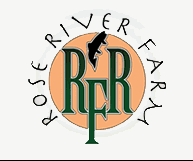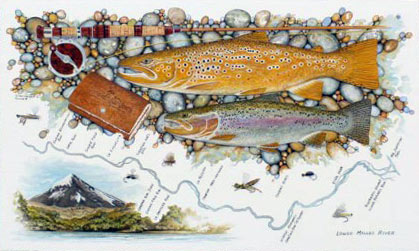Rainbow Trout, February 2012, Fish of the Month!
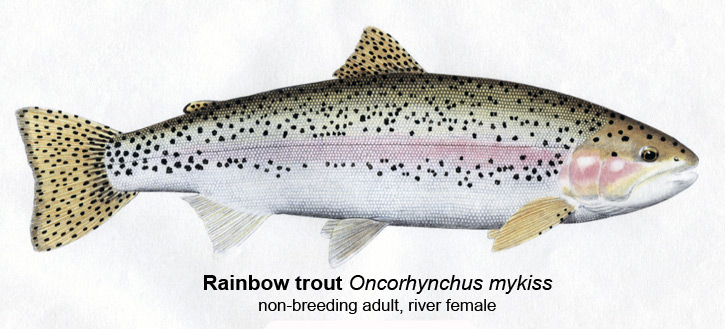
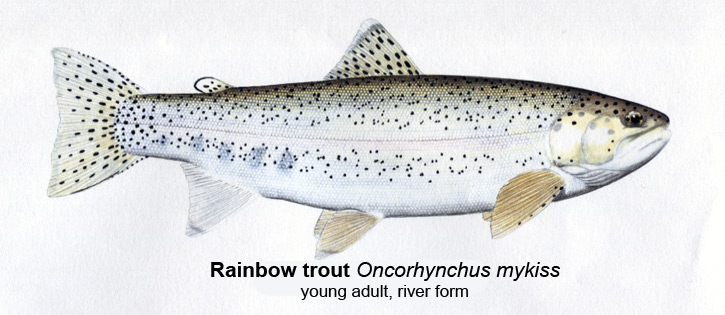
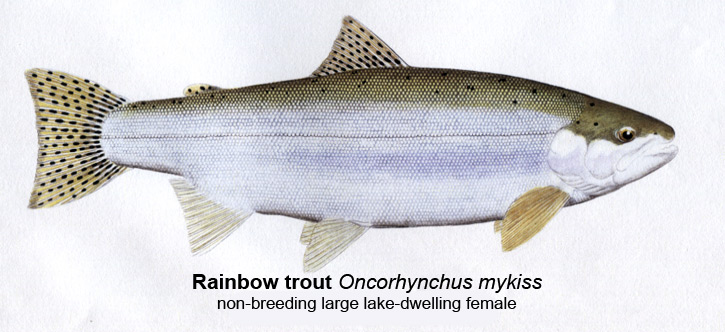
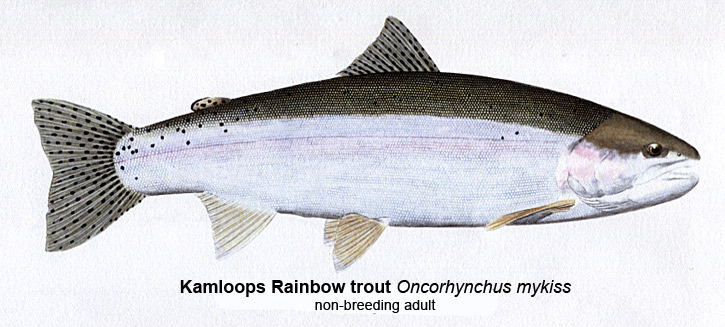
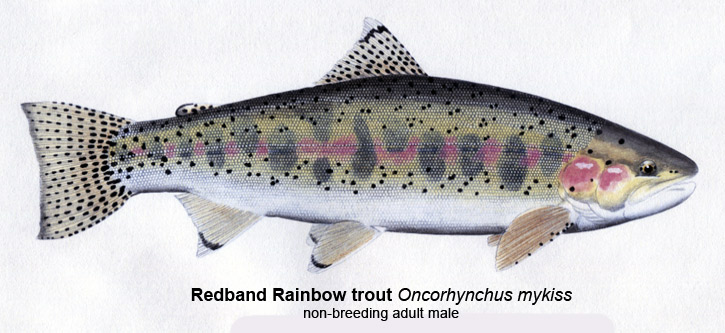 Rainbow Trout
Rainbow Trout
Oncorhynchus mykiss
Local Names:
Bow, Rainbow, Coast Angel trout, Hardhead
Average Size:
In streams, 10 to 18 inches
In Lakes, 16 to 24 inches
0.5 to 8 pounds
Distinguishing Field Marks:
Color and color pattern are reliable distinguishing field marks for this species. (See the illustrations.)
-
Rainbow trout vary extremely widely, especially in color. (see illustrations)
The sides, back, tail, adipose, and dorsal fins are (usually) lightly or heavily marked by small black spots.
The adipose fin can be diagnositc, in that it typically has a black outline on its trailig edge.
-
The caudal peduncle is thick, making it difficult to lift a lagre Rainbow trout by the base of its tail.
-
There are 8 to 12 principle rays in the anal fin.
-
The tail fin is slightly forked, with rounded lobes.
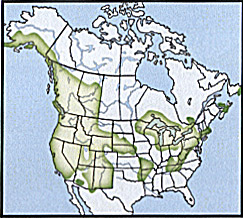 North American Range:
North American Range:
Map to the right shows approximate range in North America.
Diet:
In streams, Rainbow trout fry feed on small planktonic organisms that drift to them on the stream's current. As parr, they feed mainly on immature aquatic insects and a broad range of other invertebrates, as available. Adult Rainbows are, like all trout, opportunistic and take whatever foods are available, relying heavily on aquatic insects for the bulk of their fare. It is, however, common knowledge that large arctic Rainbow trout are very happy to eat mice that have stumbled into the water.
Lake-dwelling Rainbow trout feed on insects, crustacens, and small fish.
Fly Fishing for Rainbow Trout:
Rainbow trout have been very widely distributed throughout temperate regions of the world. The accompanying range map reflects this trout's broad North American range. Anglers can narrow the field of Rainbow trout fishing possibilities by looking for them in their preferred habitats. In streams and rivers, these fish will be found mainly in faster, well oxygenated sections of streams and rivers. That said, though, they also inhabit medium and large lakes where they provide excellent still-water fly fishing opportuinites, both from shore and small water-craft. The next focusing factor for Rainbow trout fly-fishers are watershed-specific food sources. Generally speaking, stream-dwelling Rainbows will respond well to flies immitating or suggesting indiginous aquatic and terrestrial insects, although streamers are also very productive, especially in high water flows. To here inclusively list those flies most likely to entice Rainbows into taking would be to leaf through all the pages of any good North American fly pattern reference book. So, for the sake of expediency, we'll refer you to local fly shops, guides, and outfitters for that information. Studying the waters where you fish for Rainbows, with an eye to the whole system and its inhabitants, will prove to be the most reliable personal knowledge base.
Equipment? Well, again, because of this trout's extremely wide distribution and habitat preferences, all but the heaviest fly fishing equipment may be appropriate. Your favorite fly tackle, especially in terms of water types where you use it, will be your best guide to what outfit to carry. Small streams holding small trout will be most comfortably covered with 7 ½ to 9 foot rods in the 3 to 6 weight classes. For this work, the simplest reels will serve well. In larger rivers, where you'll be throwing wets, streamers, and big dry flies you'll want 9 to 10 ½ foot rods carrying 6 to 8 weight lines. At this level, reels with strong, smooth drags and sufficient backing capacity can be important. This same gear is appropriate for Rainbows in lakes as well except that when fishing from a float-tube rods should be a minimum of 10 feet long, this to keep the line, during casting, as high above the water as possible. These longer rods for this specific use are usually designed to carry 3 to 6 weight lines.
Rainbow trout have been so widely distributed as they have, in part, because they are excellent game fish. They are active and willing to take all manner of anglers' presentations. When hooked, they are strong fighters that will often punctuate powerful runs with acrobatic jumps.
As has been suggested in previous articles in this series, Anders Halverson's An Entirely Synthetic Fish is a most interesting read, focusing its research on the global spread of this species and the effects of those introductions on the watersheds where they have succeeded.
Does February's monthly entry seems a bit vague? That is the result of the fact that an entire book devoted to all aspects of the life and times of this species could be written and illustrated.
Written by Peter Thompson
Peter, or "Trout" Thompson to his friends, simply refers to himself as an 'educator,' concentrating primarily on environmental and ecological issues. But he is an outstanding illustrator, excellent writer and fly fisherman "par excellence!" His artwork is in the permanent collections at the New York State Department of Environmental Conservation Salmon River Hatchery in Altmar, New Yorkj; in The New England Aquarium in Boston, Massachusetts; in the Norwalk Maritime Center in Norwalk, Connecticut; and in the Wells Reserve National Estuarine Research Center in Wells, Maine. Personally, I'm hoping to make some of his artwork part of my 'personal' permanent collection as well.
Oh . . . and he can tie one mean fly, too!!!
We'll be posting scans of his artwork on our Salmon and Steelhead Fly Recipe pages and they are made available. In the meantime, you can browse a few of his artworks below (prices are marked if they're for sale).
Email peter.thompson@aslf.org if interested in purchasing his artworks or books.


